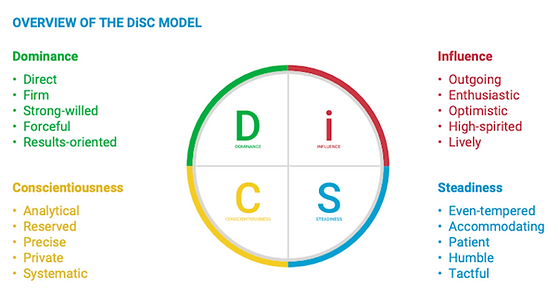In an increasingly dynamic workplace, being able to understand employee dynamics and make best use of team resources to achieve maximum performance has become a mantra for success. One highly effective methodology adopted by an increasing number of organizations these days is that of adopting DISC management and psychometric profiles. This model provides vital insight into human behavior and style of communication, understanding each other within the work teams, hence creating an effective and cooperative workplace environment.
What is DISC Management?
DISC management is the utilization of the DISC assessment tool, a behavioral profiling system that bases its results on four primary personality traits: Dominance, Influence, Steadiness, and Conscientiousness. This model was first created by psychologist William Marston in the 1920s and has since grown into an integral part of the understanding of workplace behaviors.
Dominance (D):
Dominance people score high on the D dimension and are mostly aggressive, competitive, and results-oriented. They tend to thrive well in challenging conditions and are mostly considered to be a leader. The person focuses on results and achievement of objectives.
Influence (I):
The Influence scoring people are normally enthusiastic, persuasive, and people-oriented. They tend to do well in social situations, developing relationships, and motivating others. They are strong on collaboration and communication.
High trait steadiness scorers.
This includes traits such as being calm, patient and compassionate. High scorers require teamwork and stability while being the ‘glue’ of teams that keep harmony intact as they support teammates.
Conscientiousness.
Analysis and detail. A high scorer in the above domain is analysis, careful and systematic. In such tasks as require precision and thoroughness, they normally perform well.
With this knowledge of personality characteristics, the managers can adopt the right approach as required by their teams, thus ensuring more coordination and performance.
Role of Psychometric Profiles
Psychometric profiles are a set of more comprehensive assessments that try to measure cognitive abilities, personality traits, and behavioral styles. These profiles explain how people think, feel, and interact with others, which enables organizations to make informed decisions about recruitment, team formation, and leadership development.
Some psychometric assessments encompass personality tests, aptitude tests, and emotional intelligence evaluations. All these instruments serve different purposes but feed into a broader understanding of the potential that an individual might offer at work.
Integration of DISC Management with Psychometric Profiles
The integration of DISC management with psychometric profiles gives an overall picture of employee behavior and abilities. Here are several benefits of this integration:
Improved Team Dynamics: A manager will be able to balance a team of people using DISC profiles to determine diverse strengths. For instance, the high Dominance with those strong in Steadiness will be combined in a way that allows the individual to balance between being assertive and empathetic in the best manner to work as a team.
Improved Communication: The DISC styles are known to vary in communication methods. High Influencers may be directed by a collaborative and vibrant method, while data discussion may appeal to a Conscientiousness individual. The fact is that if you vary the style of communicating, the message is welcomed by managers.
Conflict often springs from misunderstandings or the style of communication that might conflict with each other. A manager would identify potential friction points from DISC assessments and psychometric profiles so as to deal with them before the occurrence of conflict, thereby creating a better harmonious work environment.
The firms will tailor development programs that take account of the needs in assessment. For instance, one may have a higher value on Dominance. So it will be of better assistance if the same develops or enhances his/her skills regarding leadership. On the other hand, he or she can work to enhance his skills at working with conflict. Hence this kind of specific strategy promotes growth in that respective strength and aspiration among individuals.
Informed Recruitment Decisions: While hiring, the DISC profiles of candidates can be useful for an organization in recruiting people who fit well into the teams already established. This results in increased job satisfaction and retention rates.
Implementation of DISC Management and Psychometric Profiles
To incorporate DISC management and psychometric profiles effectively into your organization, you should:
Assessments: Provide the DISC assessments and the appropriate psychometric tests to the team. This would provide an initial understanding of the individual and team dynamics.
Analysis of Results:
Collaborate with a professional for analyzing the result. Different profiles need to be understood to implement it successfully.
Preparation of Action Plans:
Prepare action plans on the basis of assessment results to work on communication styles, team formations, and individual development goals.
Train Managers:
Prepare the managers so that they could understand and apply DISC and psychometric insights to their full potential. This training may improve their capacity to handle diverse teams and resolve team conflicts.
Monitor Progress:
Monitor the outcome of such practices on the dynamics of teams, their performance, and employee satisfaction levels. It should be readjusted accordingly for better results over time.
Conclusion
The integration of DISC management and psychometric profiles into your organizational strategy would significantly enhance workplace dynamics. Understanding individual behaviors and communication would make teams work in a more productive manner with increased employee satisfaction. In the future, the evolution of the workplace will mean that these tools will be essential for organizations that aim to thrive in such a changing environment. Investment in people and understanding unique contributions can create a culture of excellence that drives success in business.



